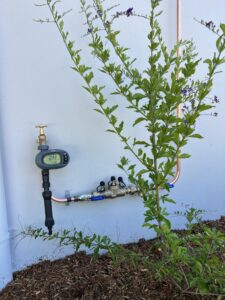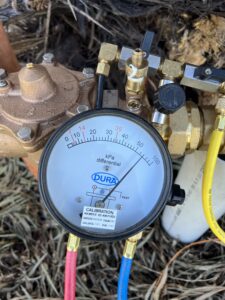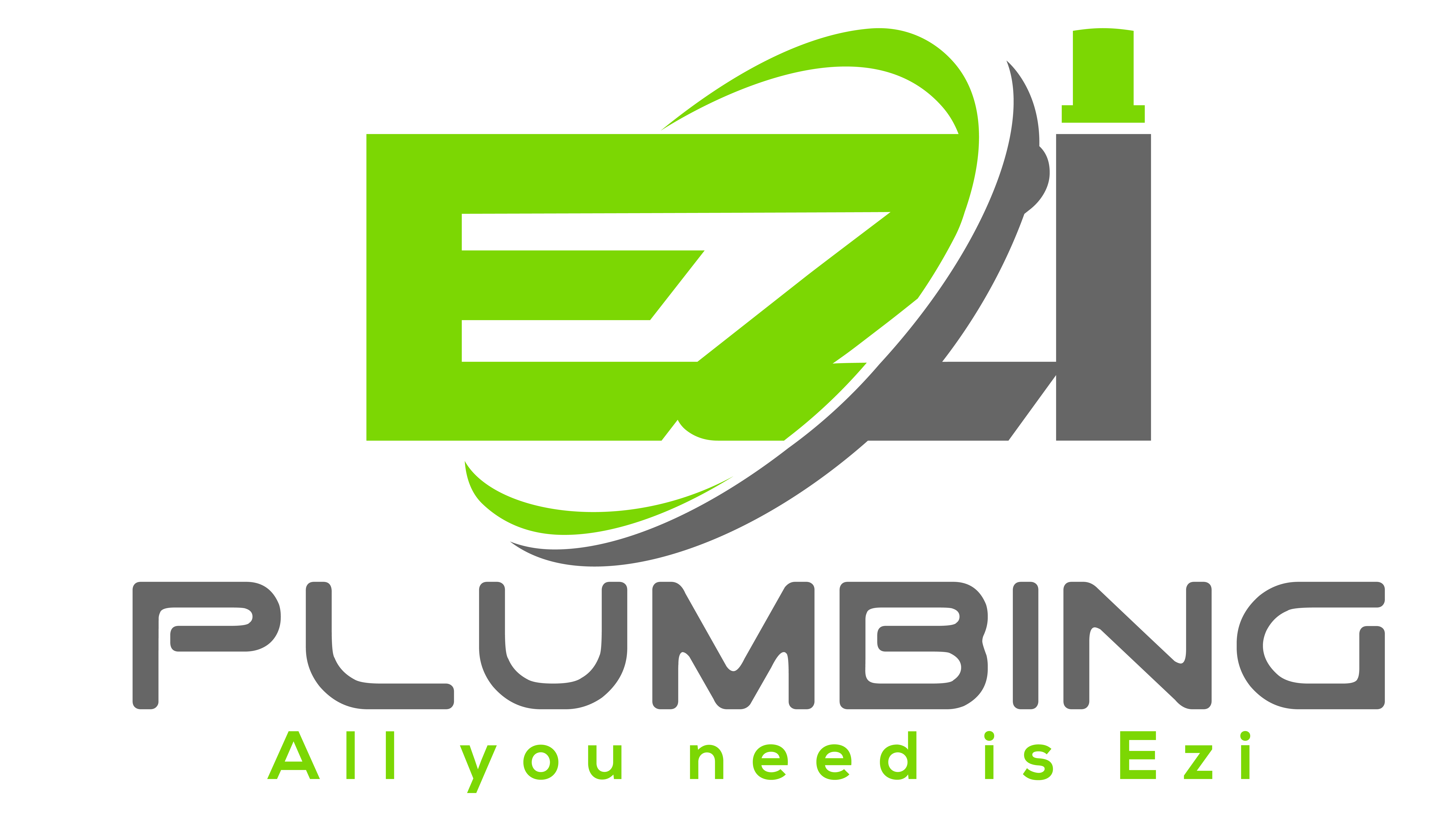Backflow prevention is important to our drinking water supply as it helps to prevent contaminated water from flowing back into the clean water supply. This can occur due to changes in water pressure, such as during a fire or water main break.

If contaminated water enters the clean water supply, it can pose serious health risks and even cause death. Backflow prevention devices, such as check valves and air gaps, are installed to prevent the reversal of flow, and protect the clean water supply.
Regular backflow testing and maintenance of these devices is also important to ensure their proper function.

Why is it important to prevent backflow?
Backflow doesn’t just affect you and the people on your premises. If the contaminated water enters the water main drinking water supply, it can flow to other property connected to the water main, affecting a significant number of people.
For this reason, every household or business that has a source of contamination must install a backflow prevention system.
Backflow prevention is especially important if you have more than one water system on your property and there is a possibility of cross-contamination between the two systems. For example, serious contamination can occur if you have a separate water system for irrigation or industrial processing and there is the potential for a cross connection then the drinking water supply must be protected with a backflow device as a safety measure.
How does backflow occur?
There are usually 2 reasons that can cause water to backflow or go in the reverse direction.
- Back Siphonage
- Back Pressure
Back Siphonage
Back siphonage, can occur when a water main breaks, a water pump fails, or another local user is taking an excessive amount of water from the mains. When this happens, you may not notice anything other than a reduction in the water flow.
When there is no pressure pushing the water through the pipework, water will flow to the lowest point. It creates a suction and draws all the water to this low point.
Without a backflow prevention device, low supply pressure causes water from your property to be drawn back into the main water pipework. The risk of this happening increases if your water pipes are cross connected to a secondary system.
Back Pressure
Back pressure happens when the downstream pressure increases. Anything that increases your water pressure, such as secondary water pumps, can cause back pressure.
If the pressure in the water main during peak demand decreases, then a pumped supply can force water back into the water main, which is a source of backflow.
Sydney Water backflow prevention
Sydney Water requires backflow prevention devices to be installed in certain circumstances where there is a risk of backflow contamination. This includes.
- Residential households that may have a bidet, douche spray or bidet toilet seat. Residential irrigation systems that have pop up sprinklers are also required to have a backflow prevention device installed.
- Businesses that use chemicals or other substances that could contaminate the water supply, and properties with irrigation systems.
Sydney Water also requires regular backflow testing and certification of backflow prevention devices to ensure that they are functioning correctly and protecting the water supply. Backflow information for plumbers.
Hunter Water backflow prevention
Backflow prevention devices are required under our Site Containment Backflow Prevention Standard, Australian Standards AS/NZS 2845: Water Supply – Backflow Prevention and AS/NZS 3500: Plumbing and Drainage for any property or operations that pose a risk to the public drinking water supply.
All properties that are connected to Hunter water supply system are required to be risk assessed and have an applicable site containment backflow prevention device installed. A risk assessment should be done by a licence plumber that is experience in backflow prevention to determine if the property is a high, medium or low hazard risk to the drinking water supply.
Central Coast Council backflow prevention
Central Coast Council is legally required to ensure a high standard of its potable water supply and boundary containment devices are required to protect the supply systems under its control. This is especially important if you have more than one water system on your industrial property.
What is a backflow prevention device?
A backflow prevention device prevents the reverse flow of water from a potentially polluted source into the city’s potable (drinking) water supply. Backflow prevention devices are usually fitted in the following circumstances:
- Bidets or douche sprays
- an irrigation system connected to mains water supply,
- fire hose reels or hydrants,
- a commercial or industrial activity or machinery connected to the mains,
- water outlets in proximity to pollutants,
- grease traps or chemicals,
- an underground rainwater tank that has mains water backup.
What are the different types of backflow valves?
Backflow prevention devices and valve assemblies include atmospheric vacuum breakers, dual check valves, pressure vacuum breakers, double check valve assemblies, reduced pressure zone devices and air gaps.
Atmospheric Vacuum Breaker
An atmospheric vacuum breaker (AVB) is a type of backflow prevention device that is used to protect the potable (drinking) water supply from contamination by backflow. It works by breaking the vacuum that can occur in a plumbing system when water is flowing in the reverse direction, and allowing air into the system to prevent backflow. AVBs are commonly used in outdoor applications, such as in garden hoses and irrigation systems, as they are relatively inexpensive and simple to install. However, they are not as reliable as other types of backflow prevention devices, such as double check valves or reduced pressure zone devices and are not recommended for high-hazard applications.
Dual Check Valves
Dual check valves are a type of backflow prevention device that are used to protect the potable (drinking) water supply from contamination by backflow. They consist of two independently operating check valves that are installed in series, with each check valve preventing water from flowing in the reverse direction. If one check valve fails, the second check valve will still prevent backflow. Dual check valves are commonly used in low-hazard applications, such as in residential plumbing systems, and are relatively inexpensive and simple to install. They are also relatively easy to maintain, as they can be serviced or replaced without disrupting the water supply. However, they may not be suitable for high-hazard applications, such as those that handle hazardous chemicals or other contaminants, as they do not provide a high level of protection against backflow.
Pressure Vacuum Breakers
A pressure vacuum breaker (PVB) is a type of backflow prevention device that is used to protect the potable (drinking) water supply from contamination by backflow. It works by breaking the vacuum that can occur in a plumbing system when water is flowing in the reverse direction, and allowing air into the system to prevent backflow. PVBs are commonly used in outdoor applications, such as in irrigation systems and fire suppression systems, as they are relatively inexpensive and simple to install. However, they are not as reliable as other types of backflow prevention devices, such as double check valves or reduced pressure zone devices and are not recommended for high-hazard applications.
Double Check Valve Assemblies
A double check valve assembly (DCVA) is a type of backflow prevention device that is used to protect the potable (drinking) water supply from contamination by backflow. It consists of two independently operating check valves that are installed in series, with each check valve preventing water from flowing in the reverse direction. If one check valve fails, the second check valve will still prevent backflow. DCVAs are commonly used in low-hazard applications, such as in residential plumbing systems, and are relatively inexpensive and simple to install. They are also relatively easy to maintain, as they can be serviced or replaced without disrupting the water supply. However, they may not be suitable for high-hazard applications, such as those that handle hazardous chemicals or other contaminants, as they do not provide a high level of protection against backflow.
Reduced Pressure Zone Devices
A reduced pressure zone (RPZ) device is a type of backflow prevention device that is used to protect the potable (drinking) water supply from contamination by backflow. It works by maintaining a pressure differential between the incoming water supply and the water that is being used in the plumbing system, and prevents backflow by automatically shutting off if the pressure differential is lost. RPZ devices are commonly used in high-hazard applications, such as those that handle hazardous chemicals or other contaminants, as they provide a high level of protection against backflow. They are typically more complex and expensive than other types of backflow prevention devices, such as double check valves or pressure vacuum breakers, and require regular maintenance to ensure that they are functioning properly.
Air Gap
An air gap is a type of backflow prevention method that is used to protect the potable (drinking) water supply from contamination by backflow. It works by physically separating the incoming water supply from any potential sources of contamination, such as a drain, sewer, or other contaminated body of water. This separation creates an air gap between the water supply and the potential source of contamination, making it impossible for backflow to occur. Air gaps are commonly used in high-hazard applications, such as those that handle hazardous chemicals or other contaminants, as they provide a high level of protection against backflow. However, they are also relatively large and bulky, and may not be practical in all applications.
It is important to have a professional plumber assess your plumbing system to determine the most suitable backflow prevention method for your needs.
Why do I need a backflow preventer on my hose?
The eliminate back siphonage. An atmospheric vacuum breaker is a device that prevents water backflow and can be installed on the outlet of a tap. An example of how back siphonage can occur is if you leave the end of the hose in a bucket containing chemicals and there is water main break. The pressure in the main drops suddenly and water is flowing from the break. This creates a suction and water is drawn from your property including what is in the bucket.
Do I need a backflow preventer on my sink?
Generally, not as sinks, basins, baths have an air gap. This means that the outlet of the sink is above the overflow level of the sink.
Where you would require a backflow prevention device on a sink is when a hose is attached to the sink spout and can be left in the base of the sink. The hose eliminates the air gap and therefore requires a backflow prevention device.
Do I need a backflow preventer on a hand shower?
Only if the hand shower can reach the floor. There is no air gap in this instance. An atmospheric vacuum breaker can be installed at the wall outlet of the hand shower. This will prevent back siphonage.
Where should backflow preventer be installed?
Backflow prevention devices should be installed at the specific points in a plumbing system where there is a risk of backflow contamination. Common locations for backflow prevention devices installation include:
- At the point where a potable (drinking) water supply connects to an irrigation system or fire suppression system
- In commercial or industrial buildings that use hazardous chemicals or other contaminants in their operations
- At the connection point between a property’s plumbing system and the public water supply
- In medical facilities and laboratories that use hazardous materials or chemicals in their operations
- On a hose or fire hose reel if the hose can reach a source of contamination such as a storm water sump, grease arrestor or dam.
It is important to have a professional plumber assess your plumbing system to determine the best location for backflow prevention devices, as the specific installation location will depend on the type of risk and the type of valve being used.
Contaminated water in plumbing pipe?
Backflow in plumbing refers to the unwanted flow of water or other substances from a piping system that is carrying contaminated or non-potable (not safe for drinking) water, into a clean water supply. This can occur due to changes in water pressure, such as during a water main break or fire, which can cause the water in a plumbing system to reverse direction and flow back into the clean water supply. Backflow can pose serious health risks and damage to plumbing systems. The installation of backflow prevention devices, such as check valves and air gaps. A backflow preventer is an essential part of your plumbing system for keeping your plumbing system running smoothly and preventing water contamination.
What are the hazard ratings of backflow prevention devices?
Backflow prevention devices are classified into different hazard ratings, depending on the potential health risk posed by the substances being handled by the plumbing system. The hazard ratings are as follows:
- High Hazard: For plumbing systems that handle substances that pose a serious health risk or can cause death if they enter the clean water supply. Examples include water used in medical facilities and laboratories, and water that comes into contact with hazardous chemicals.
- Medium Hazard: For plumbing systems that handle substances that do not pose a serious health risk if they enter the clean water supply. Examples include water used for irrigation and fire suppression systems.
- Low Hazard: For plumbing systems that handle substances that pose a low hazard risk if they enter the clean water supply. Examples include water used in commercial kitchens and food service establishments.
The hazard rating of a plumbing system will determine the type and complexity of the backflow prevention device required to protect the clean water supply. It is important to have a professional plumber assess your plumbing system to determine the appropriate hazard rating and the most suitable backflow prevention device for your needs. Backflow valves not only protect you against contaminates but also your neighbors who rely on the same water.
How much does it cost to put in a backflow preventer?
The typical cost of installing a backflow prevention valve is $300-$3000, and this is dependent on the size of the valve, type of valve and the existing installation configuration. This cost could be higher depending on the complexity of the installation.
On average, the cost to buy a high-level backflow prevention valve is between $450-$2500, whereas a low-level backflow preventer costs somewhere between $130 and $200. The cost can vary because of the type and size of the valve.

